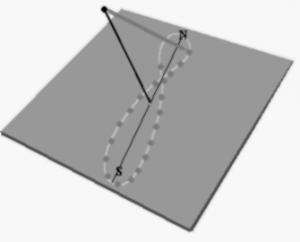Analemma of Time
Winters, especially cold and snowy winters, get to be a bit of a chore this time of year. Last week while chopping our Observatory Dome free of ice, I began to think of spring and being an astronomer, the analemma of time . I'll bet you've even seen one painted on a globe of the Earth straddling the Equator. It is that funny elongated 8 with the months listed on it. It is really quite an interesting object. It lets you know Sun's position relative to the Equator for any date.The analemma isn't just a mathematical curiosity either, it actually is drawn from Nature. Here is how to create one if you've the time and patience to make marks on a board every clear day for a year. Attach a thick stiff wire through a hole in the center of a flat sheet (plywood works fine). On the end of the wire place a marker (a Ping-Pong ball does fine). Permanently mount the contraption facing due South where it won't get toppled by the weather. At the same hour of the day [standard time only, not daylight sayings time], mark where the shadow of the marker falls on the sheet. In a year, you will have drawn an analemma.Why is the shape is an elongated 8 rather than just a North/South line? The shadow falls on one side or the other of the North/South line depending on where the Earth is in its elliptical orbit. Where the East/West deviations are greatest indicate where the Sun is running fast or slow relative to a constant clock. The time difference can be more than a quarter hour. While drawing the analemma, you'll find the Sun runs slow from January through April, runs a little fast for May and June, a little slow in July and August and finally runs fast from September through December.The Earth is closest to the Sun when it is mid winter in the northern hemisphere and farthest when it is mid summer. Earth moves fastest when it is closest to the Sun and moves most slowly when it is farthest away. These changes in the speed cause the Sun to appear to run fast or slow relative to a constant time keeper.We are lucky that the Earth's orbit is only slightly elliptical. If the Earth had a really elongated orbit such as we see in the planets around many nearby stars, Earth would spend most of its year far from the Sun in the cold depths of space. Our concepts of winter and summer (caused by the Earth's axial tilt) would be replaced by seasons based on our distance from the Sun. If this were the case, the whole Earth would experience the same season at the same time. Summers would very brief and winters would last far too long. Come to think of it that seems a lot like what we went through this winter.On the few clear Friday nights we've had this winter, we've had substantial crowds. Certainly not as many as on a warm balmy summer or fall evening, but more than you would expect. These hardy folk see the spectacular sights of the winter night including the overwhelming constellation Orion with its brilliant first and second magnitude stars in every corner. To even the most modest telescopic equipment, the middle star of Orion's sword is fuzzy. Closer inspections reveals that it is a huge mass of glowing gas with tiny pinpricks of light. These in turn reveal themselves as multiple "infant" stars in one of the universe's vast stellar nurseries - the closest one to Earth.Slightly to the northwest is our neighboring galaxy - the Great Galaxy in Andromeda. Somewhat larger than our own Milky Way Galaxy, this "island universe" was what first gave Edwin Hubble the information that led to the Big Bang Theory. As we look at it we see that other smaller galaxies circle this giant. Worth a trip, all bundled up against this cold winter, on any clear Friday night. We hope to see you soon.
- Author:
- Leslie Coleman
- Entry Date:
- Feb 1, 2001
- Published Under:
- Leslie Coleman's Columns


